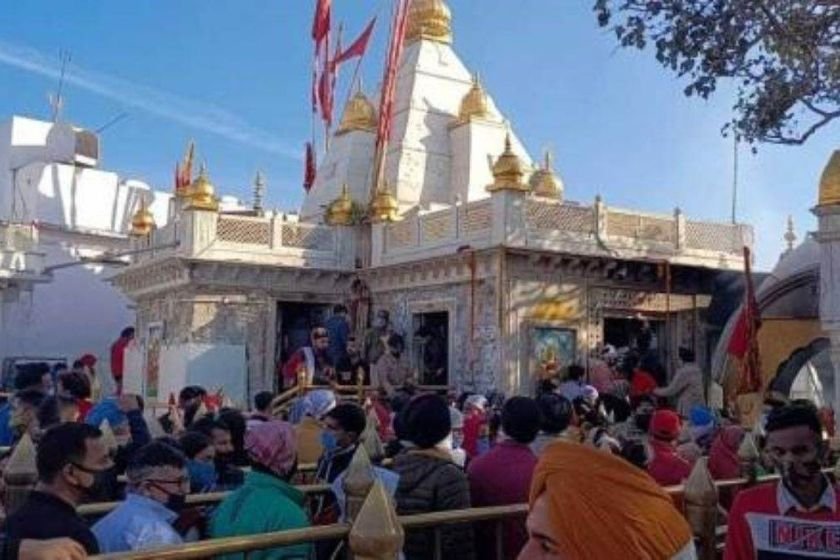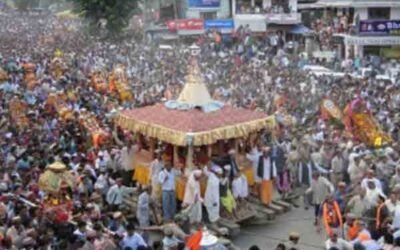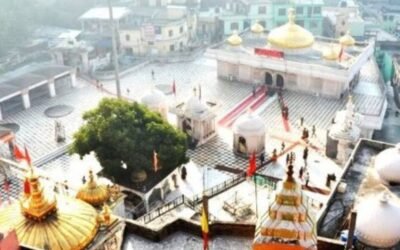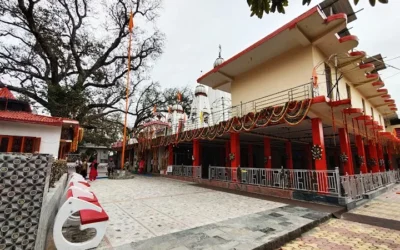📍 Location: Shri Naina Devi Ji Temple, Bilaspur District
📅 Seasons: Chaitra (March–April), Shravan (July–August), Ashwin (Sept–Oct)
A sacred summit where faith soars and hymns echo through the clouds
🌄 At the Confluence of Heaven and Hope
Perched atop a forested ridge in Bilaspur’s hills, Shri Naina Devi Ji Temple is not just a destination—it’s a spiritual lifeline for millions. During Navratri, the temple transforms into a divine theatre of devotion as it hosts one of Northern India’s most revered pilgrimage fairs.
Devotees from across Punjab, Haryana, Himachal, and beyond flock here to seek blessings from Maa Naina Devi—an incarnation of Shakti, the primordial goddess of power.
🛕 Mythical Note: According to legends, Sati’s eyes (naina) fell at this spot during Lord Shiva’s celestial dance of grief. It is now counted among the 51 Shaktipeeths—sites of immense spiritual potency.
🌸 Navratri Times Three – A Thrice-Blessed Celebration
Unlike most Navratras, Shri Naina Devi Ji Fair occurs three times annually—each coinciding with the sacred nine-night cycles:
| 📆 Navratri Season | 🌱 Theme | ✨ Significance |
|---|---|---|
| Chaitra | Springtime renewal | Start of the Hindu year (March–April) |
| Shravan | Monsoon devotion | Peak pilgrimage time (July–August) |
| Ashwin | Autumnal worship | Sharad Navratri, festival of power |
During these periods, lakhs of pilgrims ascend the stone steps, chant “Jai Mata Di” in unison, and offer coconuts, red cloth, and jasmine garlands to the deity.
🛤️ The Sacred Journey – Yatra as Offering
- Path to the Temple: The route is alive with folk hymns, devotional singing groups (jathas), and volunteers offering free water and snacks (sewa).
- Pilgrimage on Foot: Many devotees perform the climb barefoot as an act of penance or fulfillment of vows.
- Night Vigil: The temple glows under floodlights as dhol and bhajan-kirtans continue well into the early hours.
The spiritual electricity in the air feels palpable—a shared emotion woven across castes, languages, and backgrounds.
🎶 Fairground of Faith and Culture
Though rooted in devotion, the Naina Devi Navratri Fair also brings together local artistry and community celebration:
- Cultural Shows: Open-air stages host folk dances like Nati, Giddha, and devotional theatre.
- Craft Bazaars: Stalls showcase local woolens, wooden toys, devotional items, and silver trinkets.
- Langars & Prasad: Temples and volunteers provide free meals to visitors, reinforcing the culture of service.
Even in spiritual stillness, the hills hum with humanity.
🍛 Rituals & Offerings
Within the temple sanctum, rituals follow precise timings and centuries-old customs:
- Morning Aarti bathed in shankh (conch) and bell tones
- Durga Saptashati Recitations echoing across the marble courtyard
- Prasad Offerings: boiled chickpeas (chana), halwa, coconut, and sacred ash (bhabhoot)
Women in red sarees perform kanya pujan, where young girls are fed and worshipped as living goddesses on the eighth or ninth day.
Of course, Trilok! Here’s the “Plan Your Yatra” section for the Naina Devi Navratri Fair rephrased in flowing, reader-friendly paragraphs instead of a table, preserving its clarity and warmth:
🧭 Plan Your Yatra
Reaching Shri Naina Devi Ji Temple is a journey as rewarding as the destination itself. Pilgrims can approach the site via road from nearby towns like Anandpur Sahib and Kiratpur Sahib (both in Punjab), with frequent buses and taxis available. For a more serene ascent, the cable car—especially stunning during sunrise or sunset—offers breathtaking aerial views of Gobind Sagar Lake and the surrounding hills.
Accommodations are readily available, ranging from budget guest houses and dharamshalas to HPTDC-run hotels, all offering easy access to the temple during peak fair days.
While all three Navratras offer unique devotional energy, Shravan Navratri (typically July–August) sees the highest footfall and cultural activity—it’s the most vibrant time to witness the fair in its full glory.
On-site, the temple premises remain secure and well-organized throughout the celebration period. CCTV surveillance, first-aid centers, and free water stations are placed across the path to ensure a safe and comfortable yatra for visitors of all ages.




